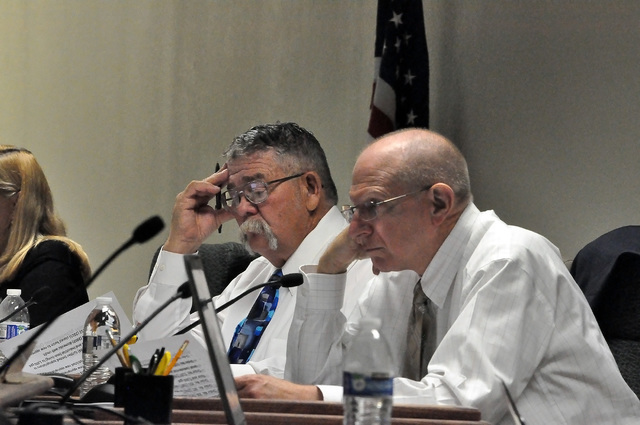
Members of the Legislative Commissions Subcommittee to Study Water on Monday sought solutions on how to deal with water appropriation and dropping water levels in Pahrump and across Nevada.
The Legislative Commissions Subcommittee to Study Water heard from more than a dozen community stakeholders and officials gave the lawmakers their suggestions on how to address water overappropriation in the valley.
Nevada has 256 basins and currently, over 20 percent of them, including Pahrump, are overappropriated or are on the cusp of being overappropriated, officials said.
And Im sure thats something we can all agree on, we cant continue down this path. Weve got to make some changes. So, to accept the status quo wont work, Pete Goicoechea, chair of the subcommittee said.
The Pahrump Valley has close to 60,000 acre feet of paper water rights and over 11,000 existing domestic wells. The valley also has approximately 20,000 acre feet of recharge.
Rick Felling, deputy administrator at Nevada Division of Water Resources, said water levels are static across Basin 162, but the Pahrump Valley has significant changes.
Reduced pumpage has had a positive effect in some areas, water level is rising closer to (alluvial) fans and on the (alluvial) fans, but theres a steady decline to the west and south on the valley floor, he said.
The Nye County Water District estimated that the valley lost about a foot of water per year from 2004 to 2014. Meanwhile, on the alluvial fan, the recovery was a foot of water per year in the same years.
A foot per year of water level decline for most basins would not be alarming, we see two feet in some places, three feet per year in agricultural basins, Felling said.
One can say that the basin overall is in equilibrium, but depending (on) where you are, water levels are either going up or going down. Declines continue in the areas with the highest density of domestic wells and that is on the valley floor, he said.
Pahrump has the largest concentration of domestic wells in Nevada, yet most of the wells are junior in priority to water rights in the valley.
Under state law, the domestic wells would be the first pumping to be curtailed. The state law focuses on water rights, seniority and proof of beneficial use.
Nevada State Engineer Jason King said after observing changes in water pumping in Pahrump, his office had taken an opportunity to be proactive and get together with stakeholders to put together a groundwater management plan.
Somehow, that has been viewed, that has been couched as the states engineers office is out here for a water grab, King said during the meeting. That we are interested, that its our charge to go in and take these domestic well owners property rights and take them away. And I dont know how that happened, Ive made this statement several times to this crowd before that that is not our intent.
Some residents called for a moratorium on growth, but King said he supports domestic well metering.
As a manager of water in the driest state in the nation, in my perfect world, I would like every bit of water metered, he said.
Wendy Barnett, president of Utilities, Inc. of Central Nevada said the valley needs balanced, responsible growth and the preservation of water.
I am not for a complete moratorium, I think that might be the death of our community, she said.
Pahrump Utility Company, Inc. General Manager Gregory Hafen II said the company supports water conservation credit and suspension of use-it-or-lose-it law. He also said Pahrump Utility Company, Inc. supports metering of all water users in the overappropriated basin.
You cant manage something you cant measure, he said.
Officials said stakeholders need to act now and be an integral part of the solution and not wait for state engineers office to take action.
The problem is certainly not going away, Felling said. Even without the pumping more than the perennial yield in Pahrump on the valley floor, we are going to see a consistent water level decline of about a foot per year, and then over the next decade or two to four decades, we are going to see thousands of domestic wells fail because theres no water.
The subcommittee has been gathering information from different groups across the state and will work on recommendations for the 2017 legislative session during its last meeting in August.
Mondays meeting in Pahrump was the subcommittees fifth in communities across the state.
The Legislative Commissions Subcommittee to Study Water will hold its last meeting at 9 a.m. on Aug. 26 in Carson City. The meeting also will be teleconferenced at the Grant Sawyer Building located at 555 E. Washington Ave., in Las Vegas.
Contact reporter Daria Sokolova at dsokolova@pvtimes.com. On Twitter: @dariasokolova77